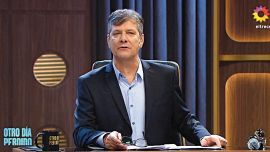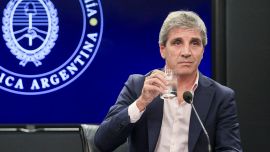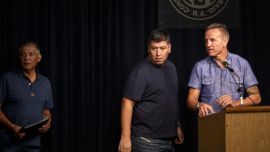On the evening of July 31, as Economy Minister Martín Guzmán and President Alberto Fernández discussed yet another extension of a deadline for creditors to accept a debt restructuring offer expiring in a few days, they decided they’d had enough.
Even before the coronavirus pandemic, the government said it was unable to pay its debt and Fernández – who took office in December – had made clear he would put the needs of Argentines ahead of bondholders. That meant taking a hard line.
But Argentina, mired in the ninth default in its history, is on pace for its worst contraction ever. Talks had dragged on during eight months with half-a-dozen deadline extensions, multiple proposals, and hours of negotiations with some of the world’s largest funds conducted over Zoom. The difference with creditors was about three cents on the dollar.
The complexity of rebuilding the economy with no access to credit, in the middle of a pandemic and just years after resolving the last painful default that dragged on for 15 years brought more pragmatism to the current team and put into motion a frantic three days of negotiations that culminated in a US$65-billion restructuring agreement.
In the hours that transpired between the initial Friday decision and an announcement for a deal worth about 55 cents on the dollar early Tuesday, the country and three groups of creditors holding over half of the country’s debt met halfway.
This story is based on interviews with a dozen people with direct knowledge of the discussions, who requested anonymity discussing private conversations.
Wheels turn
On Sunday, August 2, despite an interview with Guzmán on the front page of a staunch pro-government newspaper delivering an ultimatum to creditors to take the latest offer or face significant delays, the wheels were already turning to reach a deal.
The minister, a 37-year-old protege of Joseph Stiglitz, lobbed in calls to his financial advisers at Lazard Ltd to ask them to update different debt models to present to Fernández.
The main request the minister had made to the advisers was simple, to bring forward interest and principal payments, an idea that both sides had discussed before. It was a change that may have seemed cosmetic but that meant an improvement for creditors concerned with the time value of money, even if Argentina wasn’t putting forward more cash. Guzmán met Fernández at the presidential residence on Sunday afternoon and got the green light to make the adjustments and go back to creditors. The government was also ready to accept bondholder interpretations on some legal loopholes.
BlackRock’s role
The key step to unlocking a deal came from an unexpected ally: BlackRock Inc.
Despite early run-ins with the fund’s executives in talks, Guzmán had built a good rapport with managing director Jennifer O’Neil. Both under 40, they share similar temperaments – cool, collected and formal, according to people involved in talks.
During more than six hours of negotiations spread over several calls with her through the weekend, an agreement was reached.
O’Neil then spoke to a few key creditors between Sunday and Monday while the three major creditor groups went back to get buy-in from about 30 funds. The bondholder groups, which began the process with competing proposals, had banded into a single bloc in late July amid a lack of progress.
In addition to BlackRock’s leadership, the agreement involved heavy lifting from fund managers at Ayres Investment Management and Monarch Alternative Capital, as well as government advisers, particularly Sebastian Loketek of Bank of America Corp, the people said.
BlackRock wasn’t always seen as a unifier in the process. At one point, talks stalled after confrontations with then-negotiator, portfolio manager and former top Mexico Finance Ministry official Gerardo Rodríguez. Certain heated exchanges, including one in which Rodríguez told Guzmán he expected to outlast the minister, led the fund to appear as an adversary in local media portrayals.
At a certain point, O’Neil replaced Rodríguez as the main face on Zoom calls even though he retained a role in the process.
The Economy Ministry and BlackRock declined to comment on details of the negotiations.
Political support
On Monday, as creditors and advisers worked through paperwork and statements, smoothing out certain wording issues with funds like Ashmore Group Plc and Autonomy Capital, Guzmán paid a visit to the home of Cristina Fernández de Kirchner to discuss the deal, two of the people said.
While it was understood that the current vice-president – who ran the country from 2007-2015 – had the power to “veto” the accord, she gave it her approval, said another person. On Tuesday evening, President Fernández addressed her role in a televised interview.
“At one point, when I was taking a hard line, two people told me to look at the context and soften my stance,” Fernández said. “One of them was Cristina.” The other was ex-economy minister Roberto Lavagna, he said.
Lavagna had been the architect of a 2005 restructuring that imposed roughly 70 percent losses on creditors but also led to a 15-year standoff with holdout creditors infamously led by billionaire Paul Singer of Elliott Management Corp. Fernández de Kirchner had refused to concede to holdout demands and a US court order leading to another default in 2014 that was resolved by Mauricio Macri in 2016.
Another local politician actively involved throughout the process was Speaker of the Lower House, Sergio Massa. He stayed in touch with key fund managers this year to both explain how local political signalling worked and also to relay their views to Fernández, keeping him in the loop on what would be considered a feasible deal.
With the political blessing needed to close an agreement, Guzmán returned to the ministry. The government’s advisers were keen to post the release before the markets opened and the president asked to release a statement as soon as it was ready.
After many months of tension – often between the creditors themselves – the mood lightened in the final video call at 2.30am on August 4 shortly before the official release, with investors and officials sharing a laugh, the people said.
With Argentina’s bonds trading in the low 20-cent range in March, creditors weren’t always confident of a quick deal, nor one that fetched an NPV in the mid-50’s.
Now the clock is ticking to actually execute the deal, reach participation thresholds and squash the possibility of another drawn-out legal battle by September 4.
by CAROLINA MILLÁN & JORGELINA DO ROSARIO, Bloomberg


























Comments